Discover 4 easy DIY garden soil tests you can do at home to check pH, nutrient levels, and soil texture. Improve your garden’s health and boost plant growth today!
Get the dirt on your garden soil by performing these easy DIY garden soil tests yourself. To help improve the quality and health of your garden soil, you first need to understand where it stands and what it needs each year. Your garden’s thriving plants and bountiful harvest begin with the health of the soil. Use these easy soil garden tests to help you get started.
Healthy soil is the foundation of a thriving garden, but how do you know if your soil is truly ready for planting? With just a few simple DIY tests, you can quickly check your soil’s pH, nutrient levels, and texture without expensive kits or lab work. In this guide, I’ll walk you through 4 easy garden soil tests you can do right now, helping you understand your soil better and giving your plants the best chance to grow strong and healthy.
It’s time to get all nerdy with the sciency part of gardening, so go grab your shovels and let’s get diggin’!
This is a pinnable post. Tap or hover over any image in this post to pin to your Pinterest Boards.
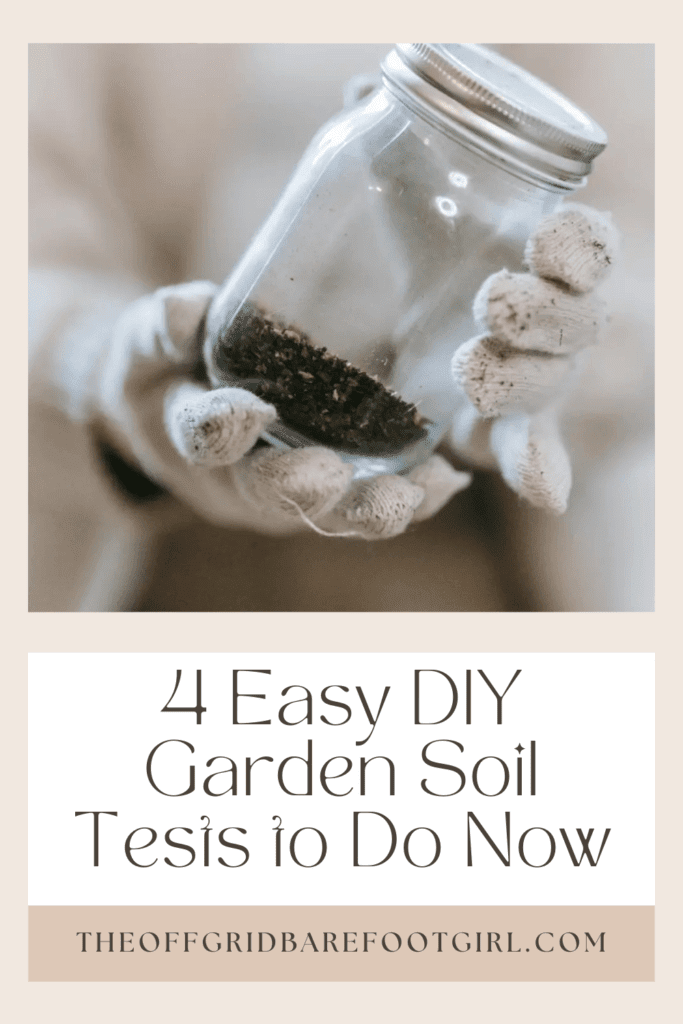
When to Perform These Garden Soil Tests
If you’re an enthusiastic gardener, it’s crucial to know when to perform garden soil tests. Ideally, the best time to test your garden soil is in the early spring before planting season begins. This way, you can gauge the nutrient levels and pH balance of your soil, giving you ample time to make any necessary amendments before sowing seeds or transplanting seedlings.
Additionally, if you notice any recurring issues in your garden, such as poor plant growth or unusual leaf discoloration, it may be worth conducting a soil test. This will help identify any underlying problems that might be affecting your plants’ health.
Regularly testing your garden soil every few years is also recommended since nutrient levels can change over time due to plant uptake and environmental factors. By getting into the habit of performing garden soil tests at the right intervals, you’ll be better equipped to create a thriving and flourishing garden. It is essential to perform these garden soil tests every spring and/or if you start a new garden bed or move to a new home.
Let’s take a closer look at the types of DIY garden soil tests we can do at home with basic household supplies you most likely already have in your pantry..
1. Mason Jar Garden Soil Test
It only takes about twenty-four hours to perform the Mason jar soil test to determine the quality and health of your soil. When you understand the structural components that make up your garden soil, you can better determine which types of soil amendments you need to add. Healthy loamy soil consists of 20% clay, 40% silt, and 40% sand, and the Mason jar soil test can test the levels of each of these components in your soil.
Materials
- One large Mason jar with a lid.
- One small hand shovel.
- Samples of your garden soil.
To Perform the Test
- Dig about six to twelve inches down into your garden soil, which is the root level of plants. Scoop out a sample of soil and fill your Mason jar to about half or one-third full. Next, fill the jar with water to the shoulder of the jar, leaving room enough for shaking. (Use this hole for your soil drainage test discussed later in this post).
- Allow the water to soak into the soil for a few minutes. Put the lid on the jar and give it a good shake for three minutes. This allows the soil to separate into the three different components: clay, silt, and sand.
- Set the jar down and wait one minute. Then, measure the sediment that has formed at the bottom of the jar, which is the sand level.
- After two hours have passed, measure the soil a second time to record the silt level above the sediment level. You will notice different soil levels to measure. You will also notice organic matter floats to the top.
- After twenty-four hours have passed, measure a third time to calculate the difference you recorded with the second measurement to determine the level of clay in your soil.
- Your calculations between the levels you recorded for the amounts of sand, silt, and clay should add up to 100%.
- Your soil should have healthy amounts of these types of calculations for healthy loamy soil of 20% clay, 40% silt, and 40% sand, which also means that you have well-draining soil.
- You can also perform an easy soil-draining test to see how well your soil drains. I discuss further instructions on how to perform a soil-draining test later in this post.
To Fix Your Soil Calculations with Soil Amendments
- If your soil is too sandy: Add compost, peat moss, nitrogen, or clay-rich soil. You could also grow ground covers to help improve your garden soil during the off-season. Sandy soil does not retain water well and causing water waste and run-off, and your plants will suffer and become dehydrated. You need to add composted organic matter to help retain the water and improve plant life in your garden. Grab a handful of wet garden soil and rub it in your hands into a small ball. If the soil falls apart, your soil is too sandy and dry, and does not retain water. While a sandy garden bed is not ideal, you can successfully grow root vegetables in it, such as beets, carrots, radishes, and potatoes. These root vegetables hate clay garden beds but adore sandy garden beds.
Other Soil Issues
- If your soil is too silty: Add sand or small gravel, compost, or other organic matter. Grab a handful of wet soil and roll it into a ball. If it clumps but falls apart easily if squeezed, then the soil is silty. Some shallow-rooted vegetables like to grow in silty garden beds, such as broccoli, lettuce, garlic, and onion.
- If your soil has too much clay: Add sand or small gravel, compost, peat moss, and clay-busting plants with strong roots. Grab a handful of wet soil and roll it into a ball. If it sticks together well and you are able to make some molds out of it, then your soil is very clay-like, and you should add some amendments to the soil to help balance the levels. Some vegetables actually tolerate clay soil garden beds, such as lettuce, snap beans, cabbage, cauliflower, and kale, since they have shallow roots and are not required to try and grow deeper into the soil and bust through tough clay. Tomatoes, which require deep roots, will not do well in clay soil garden beds.
The Calculated Results of My Mason Jar Soil Test
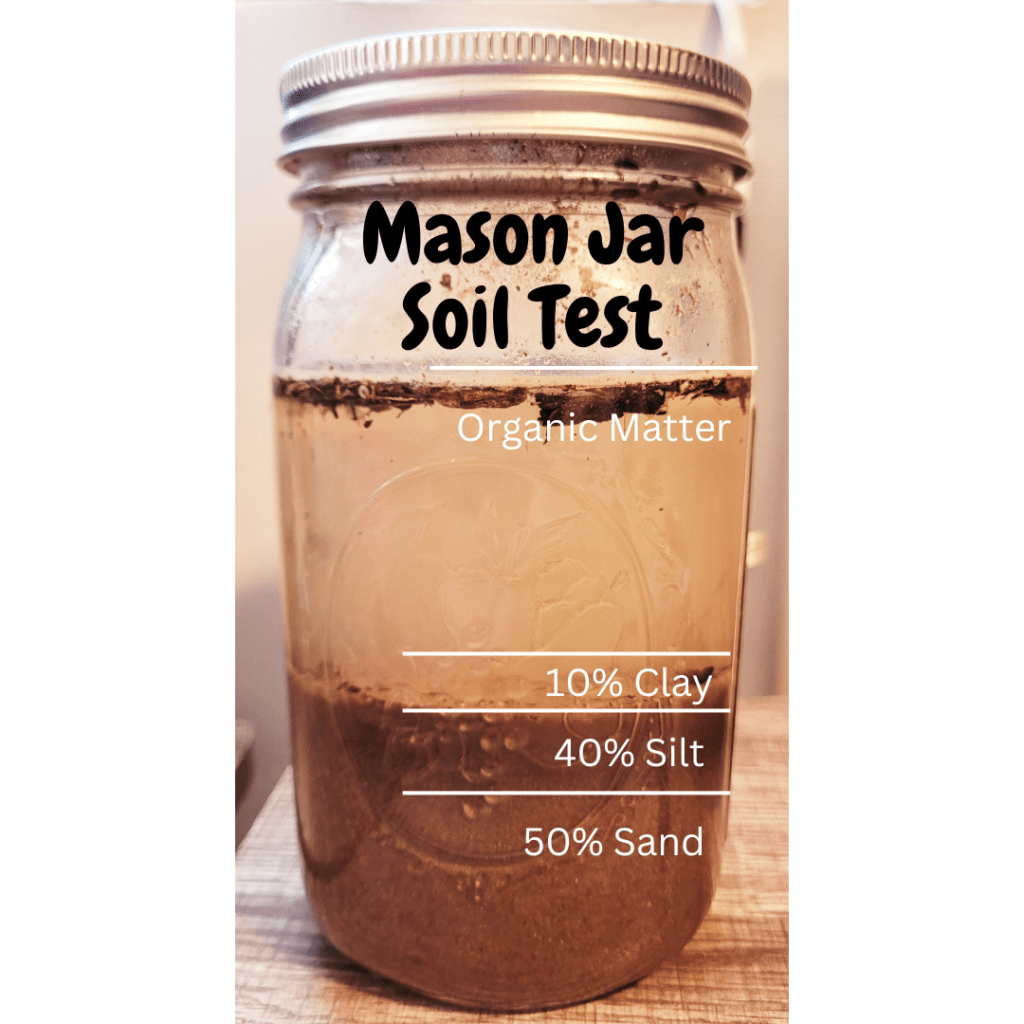
My calculations revealed the sand level was at 5 cm after 1 minute of rest time after shaking the soil jar. After 2 hours had passed, the silt level was at 4 cm.
- Height of sand layer is 5 cm.
- Height of silt layer 4 cm.
- Height of clay layer 1 cm.
TOTAL HEIGHT OF LAYERS 10 cm.
- 50% SAND=(sand height)/(total height) x 100 =50% SAND
- 40% SILT=(silt height)/(total height) x 100 =40% SILT
- 10% CLAY=(clay height)/(total height) x 100 =10% CLAY
As you can clearly see, I have some work to do in my garden beds. My soil is too sandy, although my potatoes grew nicely and big last year! This also means my soil tends to run dry much faster with this amount of sand. I will need to balance it out by adding more organic matter this year to my garden beds.
To Calculate Your Own Soil: Use This Mason Jar Soil Test Worksheet
- Height of sand layer ________ cm
- Height of silt layer ________ cm
- Height of clay layer ________ cm
TOTAL HEIGHT OF LAYERS ________ cm
- % SAND=(sand height)/(total height) x 100 =___________ % SAND
- % SILT=(silt height)/(total height) x 100 =____________ % SILT
- % CLAY=(clay height)/(total height) x 100 =____________ % CLAY
2. Earthworm Garden Soil Test
It is best to perform the earthworm garden soil test in the spring when the soil temperature is at least 50 degrees. The earthworm population is important for your garden. When earthworms are present, you know your soil is rich, damp, nutrient-compacted, and well-draining. Earthworms bring many benefits to your garden soil. It is best practice to strive your efforts to attract as many earthworms as possible to your garden beds since they improve water infiltration and soil aeration and provide worm castings (gardener’s gold!)
I have a separate post discussing how worms in the garden can improve your garden soil by installing worm tunnels throughout your garden in various areas. The tutorial is easy, and it is a simple concept of composting on a smaller scale. You can learn more about this gardening technique of attracting earthworms in your garden, composting on a smaller scale, and improving your garden soil at How to Install a Worm Tunnel and Improve Your Garden Soil. (I did a guest post on my fellow homesteader’s blog for her audience in Australia, so the tutorial of this link will direct you to her awesome homestead blog.)
Materials
- One large garden shovel.
- One piece of cardboard or tarp.
To Perform the Test
- With your shovel, dig into your garden soil at least one foot deep and place the soil out onto a piece of cardboard or tarp to spread out.
- When spreading out the soil, look for at least ten earthworms. If you find fewer than ten earthworms in the pile, add more organic matter to your garden beds. I told you it was easy!
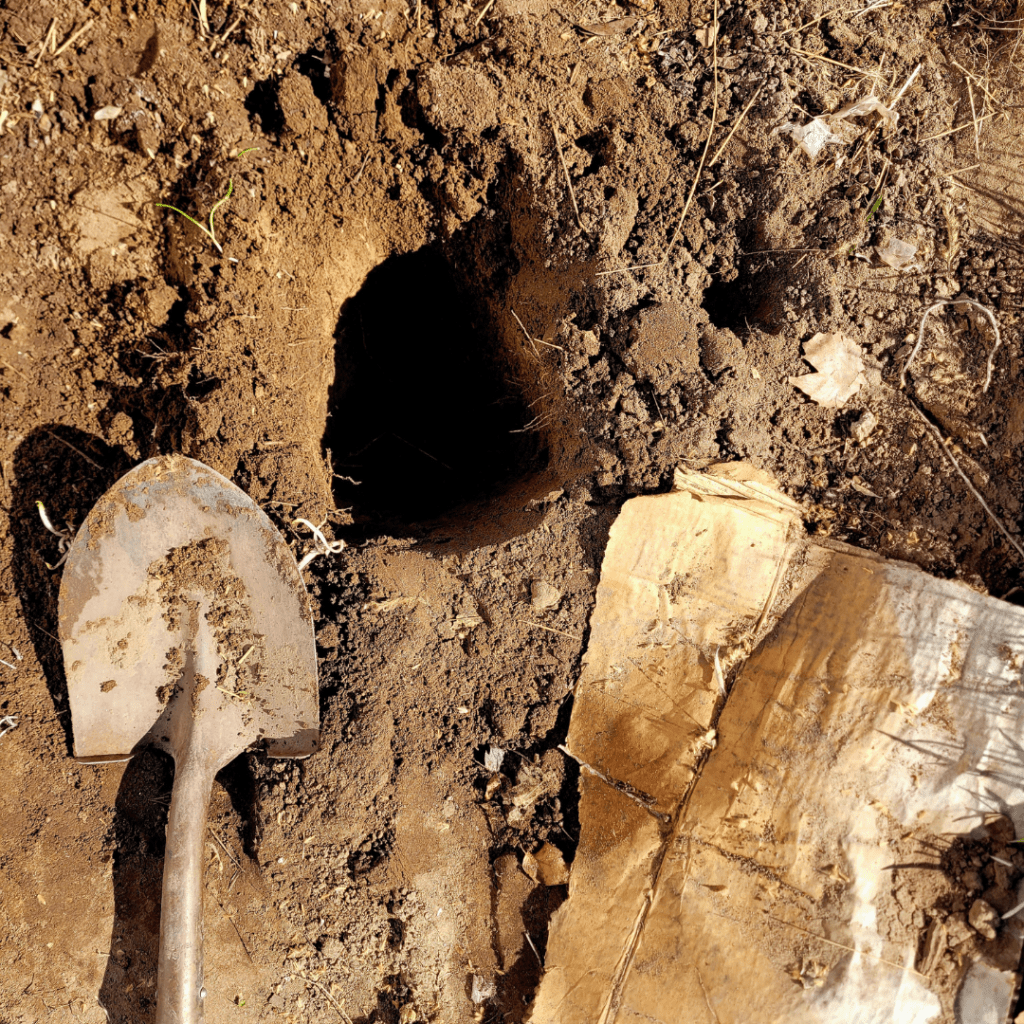
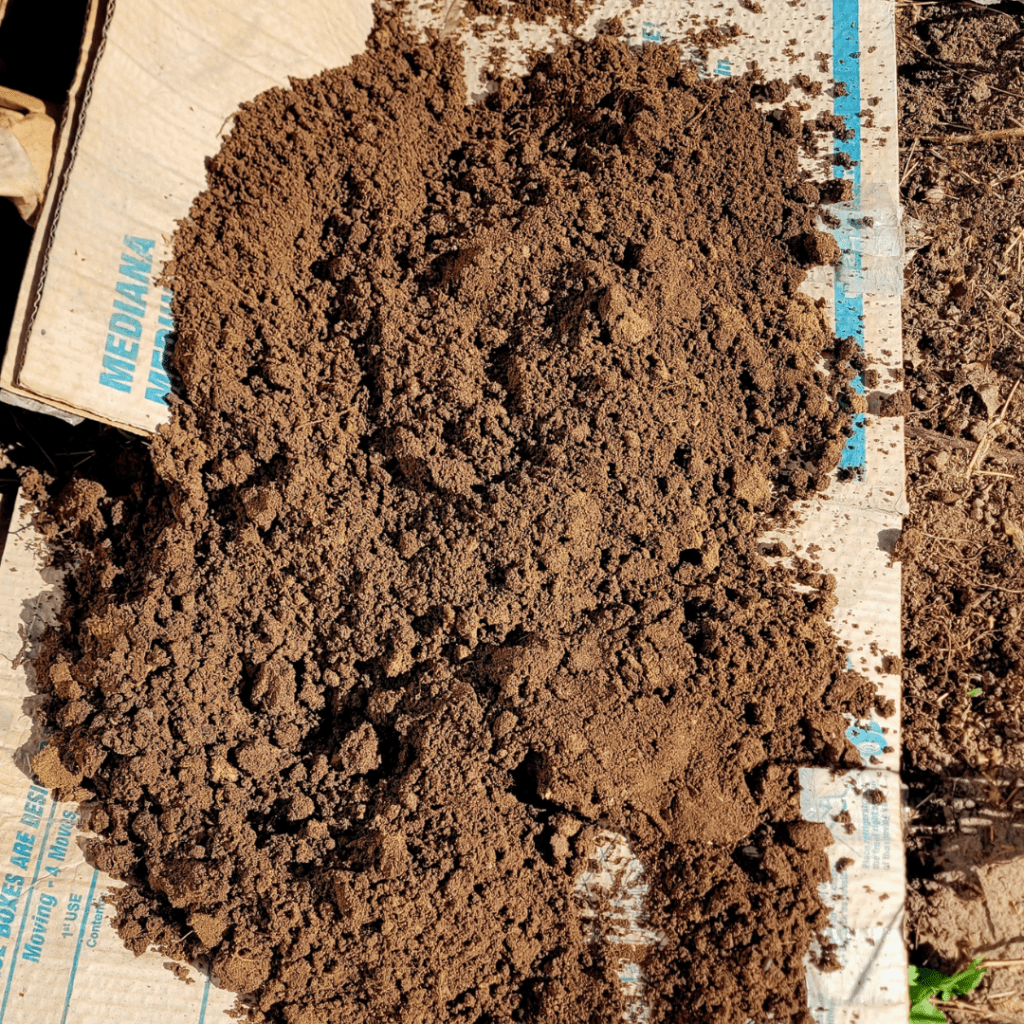
My Worm Count Results
I was able to find 8 worms in my garden this spring from this pile! I would say that is a pretty good find and my soil is moist this far down! Don’t worry, I put the little wormies back!
While I did find a good amount of worms in one area of my garden, my Mason jar soil test reveals that my soil is too sandy, which means it is too dry. I need to add more organic matter and compost to improve its structure.
3. Soil Drainage Test
You need to know how well your soil drains to have a productive and successful garden. You can do a lot for your soil to improve its health and functionality in your garden with simple steps. One of them is performing this easy soil-draining test to determine how well your soil drains each season.
Materials
- One large garden shovel.
- A hose or a 5-gallon bucket to haul water to the hole.
- One tape measure.
To Perform the Test
- Dig a twelve-inch diameter hole twelve inches deep in your garden, which is about the depth of plant roots. You can use the soil that you remove for the Mason jar soil test we discussed earlier.
- Fill the hole with five gallons of water and allow it to drain overnight. This allows the water to fully saturate the soil to reveal more accurate results of how well your garden drains. (Suppose a heavy rainfall happens one day, you want to ensure your garden will not flood, and it will hold just the right amount of water it needs to thrive and drain the remaining water appropriately. You are also testing to see how much water waste or run-off happens and how well your soil retains water for your garden).
- The following morning, fill the hole with water again. Every hour, measure the water level as it drains and record it.
- Calculate how long it takes to drain and the amount of time it takes to completely drain.
Calculating the Results
Your garden soil should drain at a rate of 1 to 3 inches per hour. With this rate of water drainage, you know that your garden can retain enough water and drain at an appropriate amount and time to be productive and healthy.
- Drainage rate 1 inch per hour: Your garden soil drainage is too slow.
- Drainage rate 1 to 3 inches per hour: Your garden soil has good drainage!
- Drainage rate 4 inches per hour: Your garden soil drainage is too fast and has an unhealthy water waste run-off.

My Soil Draining Results
My soil drained a whole bucket of water almost immediately and then completely within thirty minutes. The previous soil tests I performed in my garden revealed to me that my soil is too sandy. With how quickly my garden drained out this water, it only proves further that my soil is too sandy and dry, and my plants have not been retaining enough water regularly. I feel so sad about this and ashamed, but now I know I can improve my gardening skills.
First, I must cut myself some slack since I have only lived on this property for one year. I am excited to begin my efforts in improving the garden soil here on this new cottage homestead!
The summer climate in my area is typically hot and dry. We have been experiencing droughts each year, though we were blessed with a ton of snow recently! With the type of dry climate I live in, I need to provide my plants with better soil that retains water for them.
Therefore, I was very excited to perform these soil tests this spring!
4. Acidity and pH Level Test
You should pay close attention to the acidity and pH level of your garden soil since many plants rely on these balances. The pH (potential Hydrogen) level in your soil can make or break your garden’s success. The pH level in your soil creates the foundation of your garden beds for plants to thrive. It is the amount of acidity in the soil that plants need. There are some plants that love higher levels of acidic soil and some that require lower levels.
As good gardeners, we need to constantly test the pH level in the soil every so often since it changes with weather, rainfall, and climate, which we have no control over.
You can test your pH level with a pH test kit you can purchase at your local home improvement store, or perform your own DIY test with simple household ingredients such as baking soda, vinegar, and distilled water. This DIY project test will help you determine if you need to raise or lower the pH level in your soil.
Materials
- Two small containers without drainage holes.
- Distilled water.
- Vinegar.
- One small garden shovel.
- Samples of your garden soil.
To Perform the Test
From different areas of your garden beds, collect one cup of soil in two separate containers, with one-half cup of soil in each. Make sure the containers do not have drainage holes.
Alkaline pH Level 7-8: Add one-half cup of vinegar to the soil and monitor for a fizzy reaction. If your soil fizzes, it is likely alkaline and has a pH level between 7 and 8.
Acidic pH Level 5-6: If the soil has no reaction, add distilled water and one-half cup of baking soda to the other container of soil. If the soil has a fizzing reaction, it is likely acidic with a pH level between 5 to 6.
Balanced Soil: If the soil does not react to either of these tests, it is most likely fine.
My pH Level Soil Test Results
I performed the pH level test on samples of my garden soil. My soil did not become fizzy or do anything interesting. This reveals to me that the pH level is okay for now. I will recheck it next spring.
Acidic-Loving Plants
Some plants require an acidic soil balance of 6.5 or higher. I found out the hard way when I tried growing blueberries and hydrangeas!
One year, I tried growing hydrangeas that were a beautiful pink color, only to find out that they turned the typical blue due to the pH and acidic level in my garden.
I really do not mind at all what color my hydrangeas turn out because I am just so excited to grow and have any color and type of gorgeous hydrangea bush I can grow in my cottage garden!
Plants That Thrive in Acidic Soil
- Shrubs: Azalea, holly, gardenia, and evergreens.
- Trees: Beech, dogwood, magnolia, willow, and evergreens.
- Flowers: Caladium, foxglove, hydrangea, irises, and zinnias.
- Vegetables: Peppers, potatoes, rhubarb, and sweet potatoes.
- Fruits: Blueberries, cranberries, currants, elderberries, and gooseberries.
Conclusion
Testing your garden soil doesn’t have to be complicated or expensive. With these 4 easy DIY tests, you can gain valuable insights into your soil’s pH, nutrient balance, and texture, allowing you to make informed decisions for planting and fertilizing. Healthy soil leads to healthier plants, bigger harvests, and a more productive garden. By understanding your soil now, you set the stage for a thriving garden season.
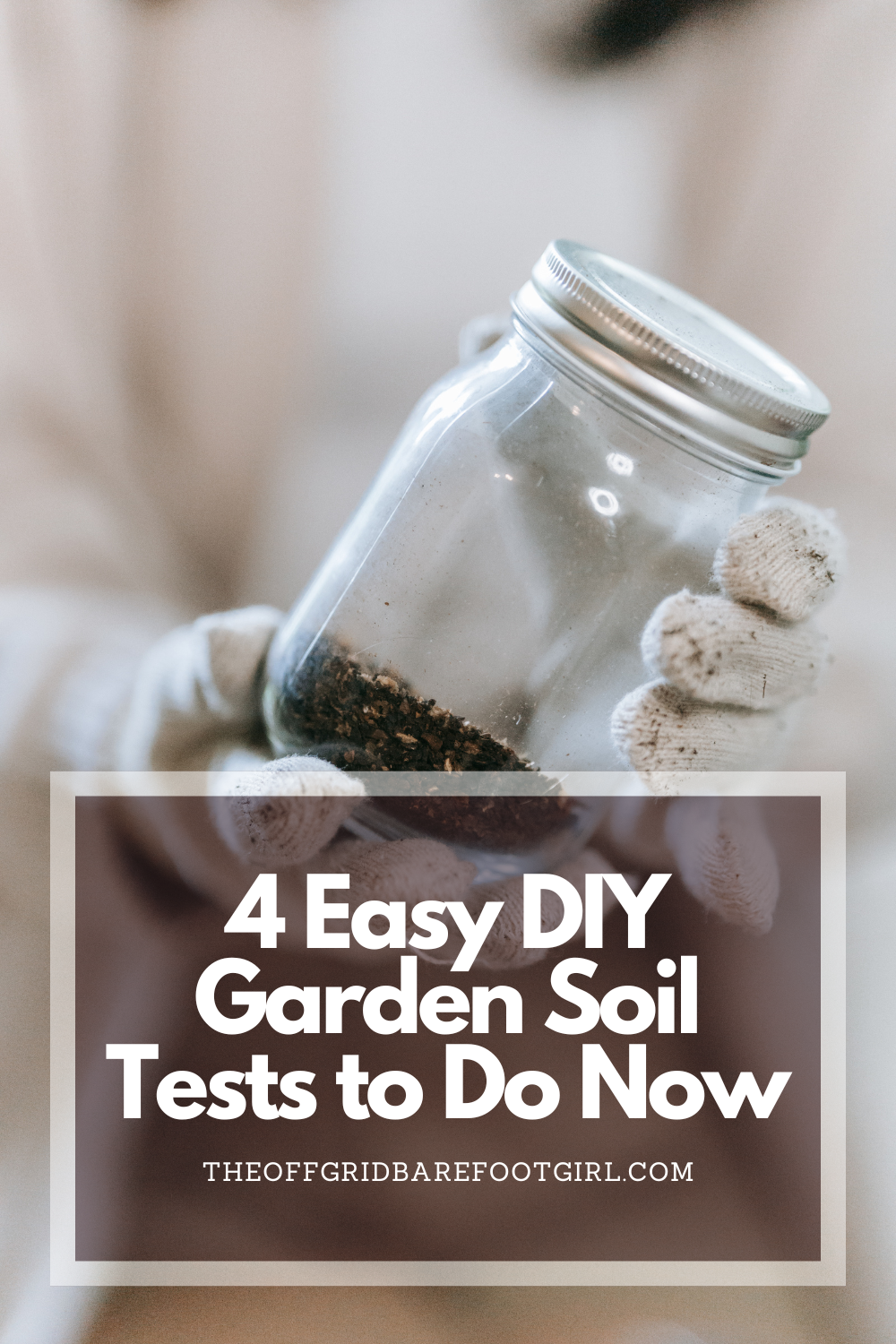
Frequently Asked Questions
1. Why should I test my garden soil?
Testing your soil helps you understand its pH, nutrient levels, and texture, which are critical for plant growth and overall garden health.
2. How often should I test my soil?
It’s a good idea to test your soil at least once a year, ideally in early spring, before planting your main crops.
3. Do I need special tools for DIY soil tests?
No! Many DIY soil tests can be done with simple household items like vinegar, baking soda, or a jar for texture testing.
4. Can I fix my soil if it’s not ideal?
Yes! Depending on the results, you can adjust pH with lime or sulfur, add organic matter to improve texture, or use natural fertilizers to balance nutrients.
Summary
I hope I have inspired you to plant your garden with these tips and products.
If you were encouraged by this post, I invite you to check out my FREE Printables Page for fun free printables, planners, and charts.
ENTER MY FREE Printables Page HERE
Here are some more of my gardening inspiration posts to check out!
How to Grow Your Own Food Without a Backyard!
My Best Spring Garden Posts in One Spot!
Spring Garden Soil Prep: How to Improve Your Soil
Seed Starting Mix 101: Everything You Need to Know!
How to Plan a 200 Sq. Ft. Vegetable Garden Layout
How I Easily Start My Seeds Without Expensive Grow Lights!
How to Create a Smart Garden: Tech Meets Nature!
The Best Cheap Raised Vegetable Garden Beds
How to Grow Artichokes: Plant Once and Harvest for 5 Years!
The Best 8 Fast-Growing Vegetables In Just 45 Days!
From Snow to Sow: Plan Your Spring Garden Now!
11 Fun Ways to Brighten Your Spring Garden with Personality
Top 10 Spring Garden Crops to Harvest in 30 Days and Eat Now!
The Best Survival Crops for Caloric Survival
My Victory Garden: What I Learned from 5+ Years
Why Every Family Should Have a Victory Garden in Their Backyard Now!
The Best Perennials for a Long-Term Survival Garden
The Best Essential Oils for Plants That Repel Garden Bugs
More Gardening Projects!
How to Grow Green Garden Peas: Perfect Plump Peas!
Hugelkultur: Does This Epic Pioneering Method Actually Work?
9 Ways to Celebrate Earthing Day in Your Garden!
Gardening Indoors: Secrets of Growing Your Food Inside!
How to DIY a Milk Jug Drip Irrigation System!
Why Cedar Mulch Is The Perfect Natural Weed Barrier
Gardening Projects
Onions: How to Grow Onions for Storage
Peas: How to Grow Garden Peas for a Bumper Crop
Carrots: How to Grow Carrots for a Bountiful Harvest
Prep Your Garden for Spring Planting with These Expert Tips!
How to Grow a Prepper Garden to Survive and Thrive
The Best Garden Tools You Need for a Productive Season
Fastest Growing Vegetables for Your Survival Garden
How to Grow Marigolds As Pest Control In Your Vegetable Garden
Must-Have Tools for a Successful Balcony Vegetable Garden
How to Effectively Combat Powdery Mildew in Your Garden
The Best Tips for Organic Gardening
How to Release Ladybugs In Your Garden for Organic Pest Control
The Best Garden Snail Control Strategies
The Best Spring Vegetables to Grow in Your Garden
Seed Starter Mix: How To Make Your Organic Seed Starter Mix At Home
How to Grow a Productive Canning Garden
How to Plant and Grow a Salsa Garden
Easiest Heirloom Vegetable Seeds to Grow Now
How to Use the Hand Twist Claw Tiller: Tackling Tough Soil
More Fun Gardening Posts to Check Out!
Planning Your Garden: How to Plan a Vegetable Garden: Expert Green Thumb Tips!
Winterizing the Garden: How to Winterize Your Vegetable Garden: Step-by-Step Checklist
Mulching the Garden: How to Make Leaf Litter Mulch
Grow a Pumpkin Patch: How to Grow a Pumpkin Patch in Your Backyard
How to Grow a Fall Garden: 9 Best Fall Crops
Clever Ways to Incorporate Indoor Composting into Your Home
How to Start Composting for the Garden: A Step-by-Step Guide
The Ultimate Guide to Composting in Your Suburban Backyard
Why I Built A Survival Garden in My Backyard
16 Best Medicinal Herbs to Grow in Your Garden Now
Blessings,
The Off Grid Barefoot Girl






